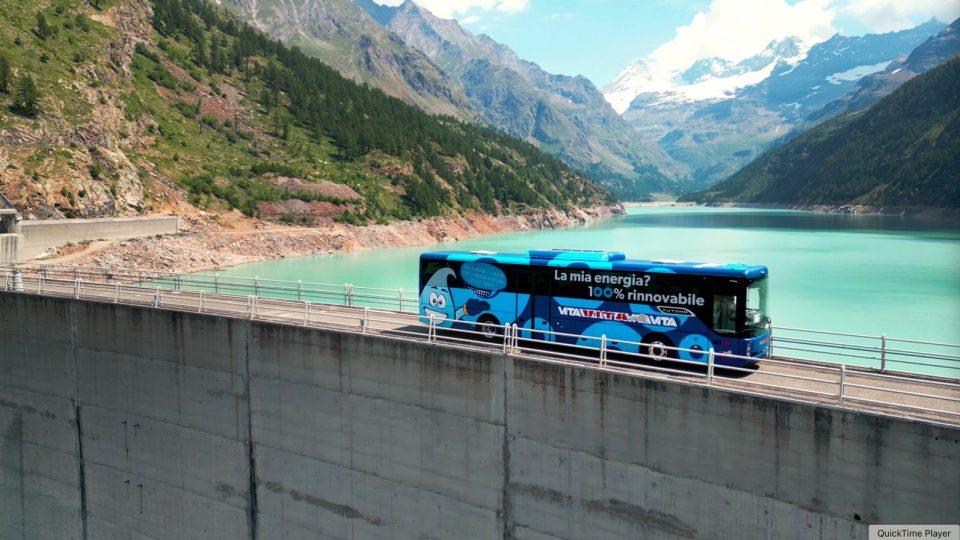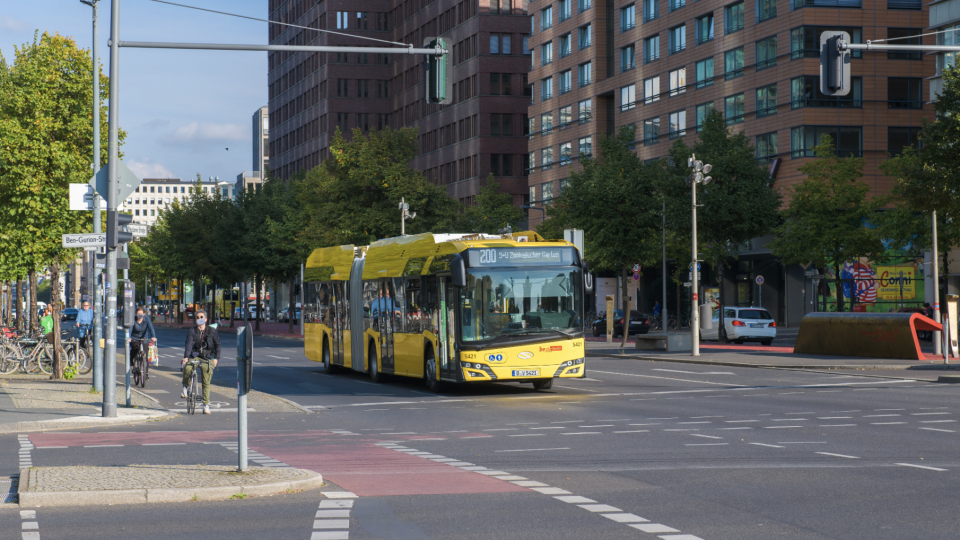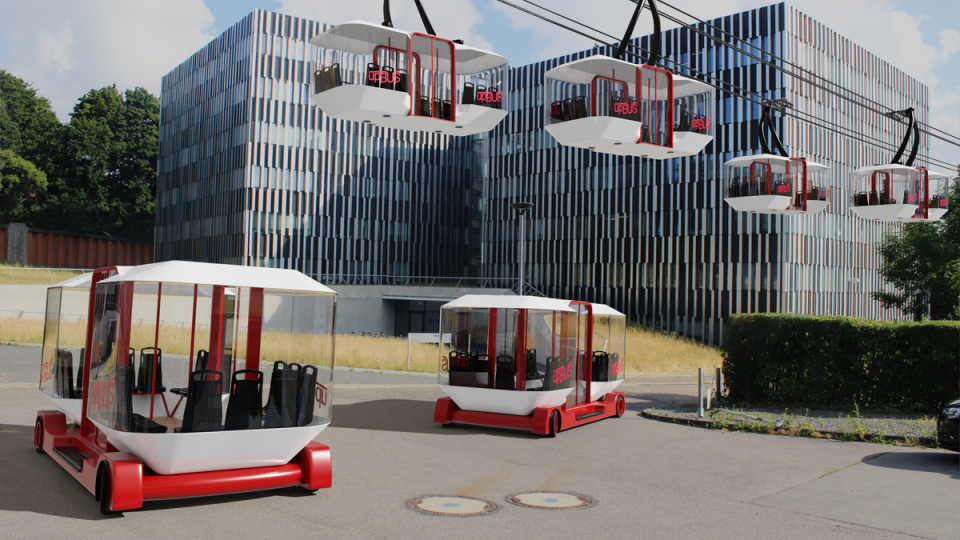US saw 12% surge in zero emission bus adoption in 2023 (with H2 buses growing 76%), CALSTART reports
Zero emission buses adopted in the US have been growing 12 percent in 2023 according to CALSTART survey Zeroing on Zero-emission buses (that takes into account electric buses both ordered and deployed). A total of 6,147 vehicles are counted for the US (dated as of September 2023). In 2023, still according CALSTART figures, the US […]
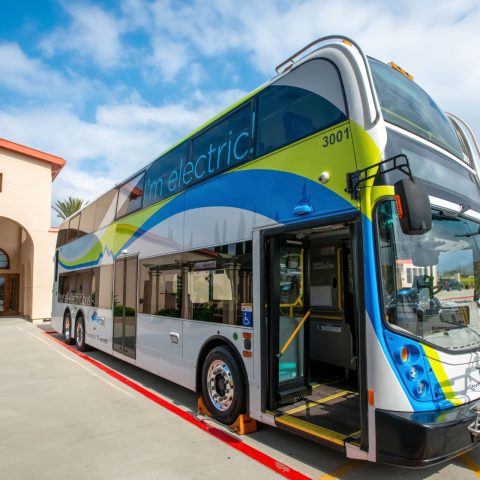
Zero emission buses adopted in the US have been growing 12 percent in 2023 according to CALSTART survey Zeroing on Zero-emission buses (that takes into account electric buses both ordered and deployed). A total of 6,147 vehicles are counted for the US (dated as of September 2023). In 2023, still according CALSTART figures, the US e-bus market had experienced a 66% increase. Particularly, fuel cell bus figures grew strongly in 2023, showing a 76% increase (from 211 to 327 units).
Canada also saw growth of approximately 12 percent and now has a total of 976 ZEBs.
North American market is experiencing a though time due to instability in the manufacturing landscape. Proterra filed for insolvency and finally sold its transit business to Phoenix Motocars (while battery business went to Volvo). Nova Bus announced that it is halting its activities in the USA while focusing its business on Canada. NFI group went through a refinancing plan to raise around $444 million. Finally, on the other hand, NFI-owned Alexander Dennis is now entering the North American e-bus market with its in-house developed zero emission bus range (first contracts in Seattle and California).

CALSTART, one third of US zero emission buses are in California
The latest data highlights California‘s continued leadership in the nationwide adoption of Zero Emission Buses (ZEBs), with an impressive count of 1,946, representing 32 percent of all ZEBs across the country. It’s no surprise, as all new sales of transit buses must be zero-emission by 2030 in the state.
New York state has emerged as a strong contender, boasting 742 ZEBs in its transit fleets. Moreover, New York state experienced the most substantial increase in ZEB adoption, with over 250 additional ZEBs integrated into its transit networks compared to previous years (+66 percent).
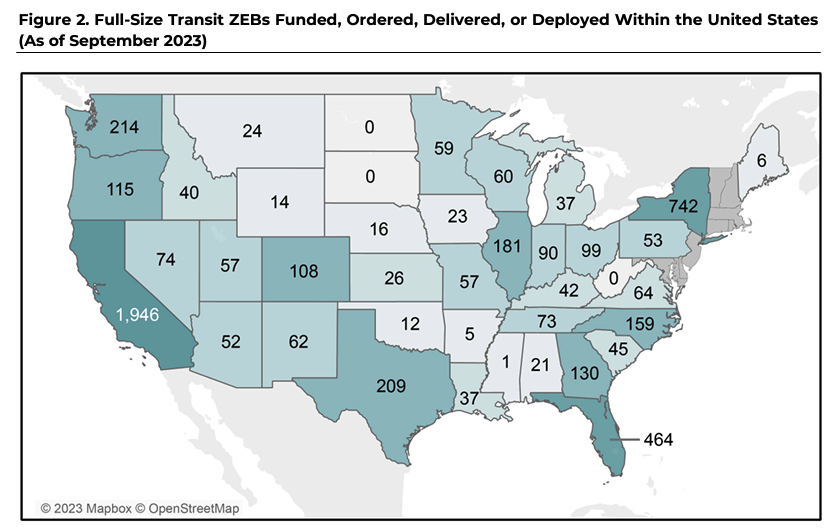
“Illinois, Massachusetts, Missouri, North Carolina, Ohio, and Oregon all increased the number of ZEBs in their respective states by more than 50 percent. BEBs remain the dominant bus type, but FCEBs continue to see strong growth in the United States with a total of 372 full-size transit buses, representing an increase of 76 percent from 2022”, the report reads.
Fuel cell buses are growing fast!
In 2023, fuel cell buses experienced robust growth, with a remarkable increase of 76 percent overall. Across the United States, 13 states reported the inclusion of FCEBs in their transit fleets. California, in particular, stands out as a leader (also) in FCEB adoption, boasting a total of 140 vehicles. The state’s commitment to FCEBs is further underscored by plans to adopt over 2,000 additional FCEBs in the coming years, as reported by the California Air Resources Board (CARB) in 2022.
CALSTART notes that “It is anticipated that interest in FCEBs will continue to grow, particularly as transit fleets move away from pilot projects and toward full-scale replacement of their internal combustion engine fleets. Based on a transit agency’s specific needs, FCEBs may be a better option than BEBs thanks to increased range and fueling time like that of a conventional diesel bus. Additionally, with the announcement from the Biden administration that seven Regional Clean Hydrogen Hubs (H2Hubs) have been selected, one of the potential barriers to the adoption of FCEBs—where to source hydrogen fuel needed for fleets—may soon be addressed. The H2Hubs are expected to produce 3 million metric tons of hydrogen on an annual basis”.
Scale adoption of zero emission buses is far
The median number of full-size ZEBs per transit agency nationwide increased from five in 2022 to eight in 2023, CALSTART found. New York’s Metropolitan Transportation Authority has the largest full-size ZEB fleet with 545 buses as of September 2023. “The Los Angeles Department of Transportation, Los Angeles Metro, Miami-Dade County, and Santa Monica’s Big Blue Bus round out the top five largest fleets in the nation with ZEBs”, report says. Approximately 60 percent of transit fleets in the United States have 10 or fewer ZEBs.
What about small buses?
Small zero emission buses are gaining traction in transit fleets, particularly for microtransit and demand-response services. As of September 2023, 1,010 small ZEBs have been adopted in the United States, showing a 15% year-over-year increase. However, the rate of adoption has slowed compared to previous years, CALSTART finds. The majority of small ZEBs are battery-electric, with no new small fuel cell electric buses (FCEBs) purchased in the last year.
Notably, transit agencies in several states, including Alabama, Massachusetts, New Jersey, Pennsylvania, and Tennessee, acquired their first small ZEBs in 2023. Illinois witnessed the largest year-over-year increase in small ZEBs, with a fourfold increase from 2022. While small ZEBs show promise for enhancing ridership and transitioning fleets to cleaner options, challenges persist in accelerating adoption rates and diversifying fuel options
Canada also grew 12 percent
ZEB adoptions in Canada grew once again (although of a small 12 percent) thanks to supportive funding and policy efforts. CALSTART sums up: “In 2020, $1.5 billion CAD was made available to support the adoption of ZEBs and supporting infrastructure. That funding was followed by $14.9 billion CAD for public transportation projects, and in August 2021, the Zero Emission Transit Fund (ZETF) was announced. ZETF also includes $10 million CAD to support planning efforts toward fleet electrification (Government of Canada, 2021). Transit agencies in Montréal and British Columbia have committed to having completely zero-emission fleets by 2040. ZEBs are now located in eight of the 10 Canadian provinces, up from seven as noted in last year’s report, stretching from British Columbia to Québec and Nova Scotia”.




